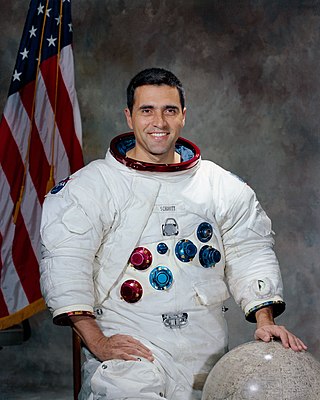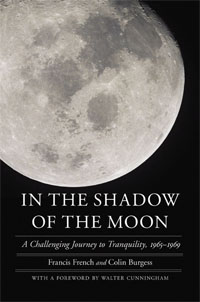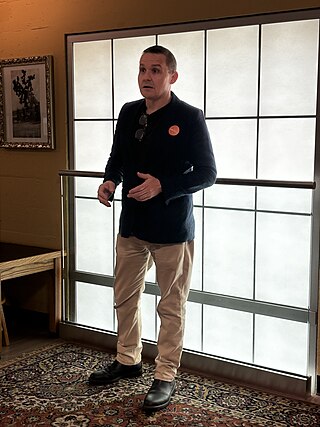Related Research Articles

Harrison Hagan "Jack" Schmitt is an American geologist, former NASA astronaut, university professor, former U.S. senator from New Mexico, and the most recent living person—and only person without a background in military aviation—to have walked on the Moon.

The Space Race was a 20th-century competition between two Cold War rivals, the United States and the Soviet Union, to achieve superior spaceflight capability. It had its origins in the ballistic missile-based nuclear arms race between the two nations following World War II and had its peak with the more particular Moon Race to land on the Moon between the US moonshot and Soviet moonshot programs. The technological advantage demonstrated by spaceflight achievement was seen as necessary for national security and became part of the symbolism and ideology of the time. The Space Race brought pioneering launches of artificial satellites, robotic space probes to the Moon, Venus, and Mars, and human spaceflight in low Earth orbit and ultimately to the Moon.

Gemini 9A was a 1966 crewed spaceflight in NASA's Gemini program. It was the seventh crewed Gemini flight, the 15th crewed American flight and the 23rd spaceflight of all time. The original crew for Gemini 9, command pilot Elliot See and pilot Charles Bassett, were killed in a crash on February 28, 1966, while flying a T-38 jet trainer to the McDonnell Aircraft plant in St. Louis, Missouri to inspect their spacecraft. Their deaths promoted the backup crew, Thomas P. Stafford and Eugene Cernan, to the prime crew. The mission was renamed Gemini 9A after the original May 17 launch was scrubbed when the mission's Agena Target Vehicle was destroyed after a launch failure. The mission was flown June 3–6, 1966, after launch of the backup Augmented Target Docking Adaptor (ATDA). Stafford and Cernan rendezvoused with the ATDA, but were unable to dock with it because the nose fairing had failed to eject from the docking target due to a launch preparation error. Cernan performed a two-hour extravehicular activity, during which it was planned for him to demonstrate free flight in a self-contained rocket pack, the USAF Astronaut Maneuvering Unit. He was unable to accomplish this due to stress, fatigue, and overheating.

The Mercury Seven were the group of seven astronauts selected to fly spacecraft for Project Mercury. They are also referred to as the Original Seven and Astronaut Group 1. Their names were publicly announced by NASA on April 9, 1959; these seven original American astronauts were Scott Carpenter, Gordon Cooper, John Glenn, Gus Grissom, Wally Schirra, Alan Shepard, and Deke Slayton. The Mercury Seven created a new profession in the United States, and established the image of the American astronaut for decades to come.

John Logsdon is the founder and from 1987 to 2008 was the director of the Space Policy Institute at George Washington University.
This is a timeline of achievements in Soviet and United States spaceflight, spanning the Cold War era of nationalistic competition known as the Space Race.

The following outline is provided as an overview of and topical guide to space exploration.
Asif Azam Siddiqi is a Bangladeshi American space historian and a Guggenheim Fellowship winner. He is a professor of history at Fordham University. He specializes in the history of science and technology and modern Russian history. He has written several books on the history of space exploration.

The United States Astronaut Hall of Fame, located inside the Kennedy Space Center Visitor Complex Heroes & Legends building on Merritt Island, Florida, honors American astronauts and features the world's largest collection of their personal memorabilia, focusing on those astronauts who have been inducted into the Hall. Exhibits include Wally Schirra's Sigma 7 space capsule from the fifth crewed Mercury mission and the Gemini IX spacecraft flown by Gene Cernan and Thomas P. Stafford in 1966.
Colin Burgess is an Australian author and historian, specializing in space flight and military history. He is a former customer service manager for Qantas Airways, and a regular contributor to the collectSPACE online community. He lives in New South Wales.

In the Shadow of the Moon: A Challenging Journey to Tranquility is a 2007 non-fiction book by space historians Francis French and Colin Burgess. Drawing on a number of original personal interviews with astronauts, cosmonauts and those who worked closely with them, the book chronicles the American and Soviet programs from 1965 onwards, through the Gemini, Soyuz and early Apollo flights, up to the first landing on the Moon by Apollo 11.

Francis French is a book and magazine author from Manchester, England, specialising in space flight history. He is a former director of events for Sally Ride Science, and a director at the San Diego Air & Space Museum.
Frederick Ira Ordway III was an American space scientist and author of visionary books on spaceflight.
Into That Silent Sea: Trailblazers of the Space Era 1961–1965 is a 2007 non-fiction book by space historians Francis French and Colin Burgess. Drawing on a number of original personal interviews with astronauts, cosmonauts and those who worked closely with them, the book chronicles the American and Russian programs from 1961 onwards, from the first human spaceflight of Yuri Gagarin through the Mercury, Vostok and Voskhod flights, up to the first spacewalk by Alexei Leonov.

James R. Hansen is Professor Emeritus of history at Auburn University in Alabama. His book From the Ground Up won the History Book Award of the American Institute of Aeronautics and Astronautics in 1988. For his work, The Wind and Beyond (NASA) -, he was awarded the Eugene Ferguson Prize for Outstanding Reference Work by the Society for the History of Technology in 2005.

How to Make a Spaceship: A Band of Renegades, An Epic Race, And the Birth of Private Spaceflight is a bestselling award-winning 2016 non-fiction book by journalist Julian Guthrie about the origins of the X Prize Foundation and Peter Diamandis, the first X Prize, the Ansari X Prize and Anousheh Ansari, the entrants into that suborbital spaceflight competition, and the winning team, Mojave Aerospace Ventures of Vulcan Inc., Paul G. Allen, Scaled Composites, Burt Rutan, and their platform of Tier One of SpaceShipOne and WhiteKnightOne.
Julian Guthrie is an American journalist and author based in San Francisco, California, USA.
Eugene Morlock Emme was an American air force pilot during World War II (1939–1945) who became a pioneering historian of aviation, and then the first historian of NASA's aerospace program.
References
- ↑ "Eugene M. Emme Astronautical Literature Awards". American Astronautical Society (AAS).
- ↑ Diane L. Thompson (8 September 2017). "Julian Guthrie Announced as Recipient of American Astronautical Society Emme Award" (PDF). American Astronautical Society (AAS).
- ↑ Jim Way (14 September 2017). "Emme and Ordway Award Winners Announced". American Astronautical Society (AAS).